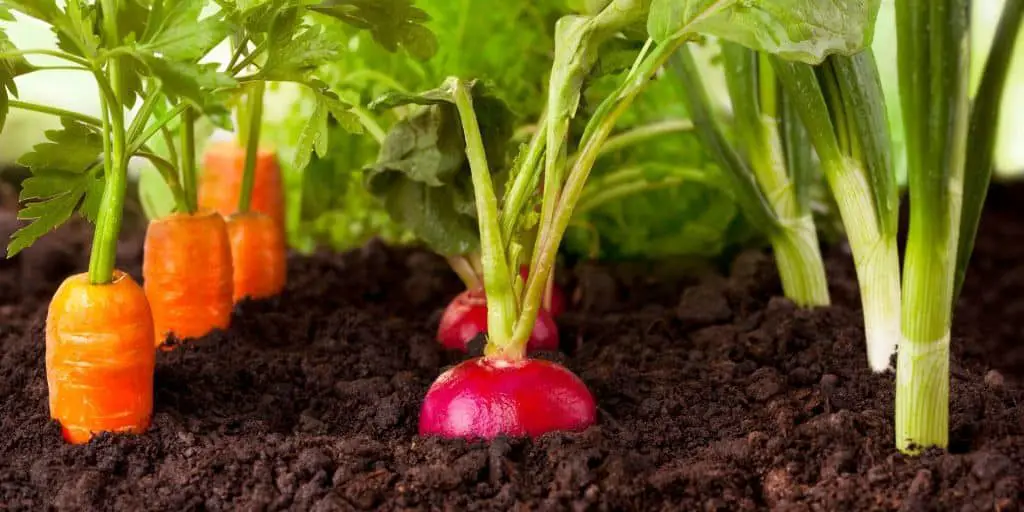
Flowers That Attract Bees To Your Garden
If you are looking for a list of flowers that attract bees to your garden, you’ve come to the right place! We compiled a great list of the best flowers that attract bees to your garden. According to gardeningknowhow.com bees and other pollinators tend to be most attracted to flowers that grow in full sun. Therefore, when you are planning a garden to attract pollinators, look for a sunny spot.
Why Pollinators Like Bees Are Important to Your Garden
Pollinators are birds, bees, bats, butterflies, and other insects and small mammals that pollinate plants. According to pollinator.org these pollinators are responsible for bringing us one out of every three bites of food that we eat. Simply put, pollinators travel from plant to plant drinking nectar and collecting pollen on their bodies. When they move to the next plant, they transfer genetic material needed for the reproduction of the flowering plant. In addition, current estimates state between 75% and 95% of all flowering plants need help with pollination.
Unfortunately, many pollinator populations are in decline due to a loss of feeding and nesting habitats. Therefore, being strategic in your home gardening and adding flowers that attract bees and other pollinators is a great way to help support the pollinator population. Below are some pretty flowers that attract bees to your garden (and a few flowering herbs!).
Bee Balm
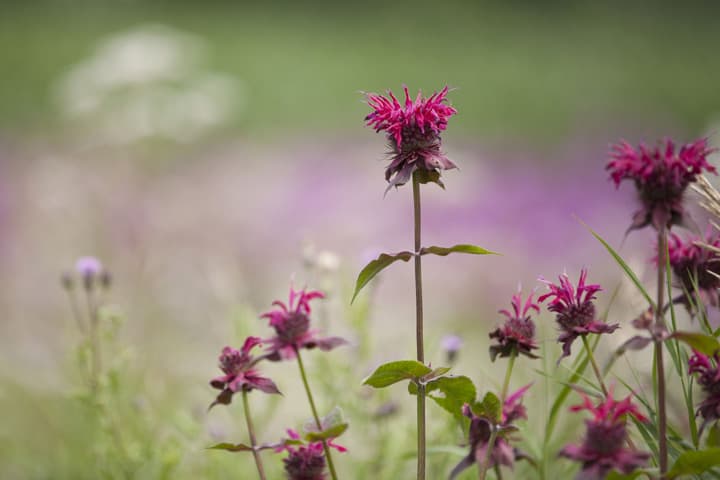
Also called Monarda, this showy summer-blooming perennial attracts bees with its aromatic foliage and colorful blossoms. Colors include red, violet, or lavender and they enjoy full sun to light shade. They grow best in rich soil that is not allowed to dry out. These beautiful summer perennials not only attract bees, but also hummingbirds. They combine well with other perennials in a border garden and bloom from mid summer to early fall.
Black Eyed Susan

Black Eyed Susans, or rudbeckia, are bright orange-yellow perennial flowers that resemble daisies with dark centers. The plants prefer full sun to light shade and form broad eye-catching clumps. Rudbeckia grow vigorously and need frequent division in spring to control their spread. Depending on the variety, you will need to divide the flowers every 2 or 3 years. They are excellent in informal gardens.
— Advertisement —
Borage

The pretty borage is actually an annual or biennial herb that blooms with pure blue, flowers that are shaped like stars. This herb is valued for its flavor and medicinal properties. Borage grows best in full sun in fertile well-drained soil. They look pretty in herb or cottage gardens.
California Poppies

These pretty flowers are the state flower of California. Common colors include red, orange, white, pink and yellow. They grow best in sandy, well-drained soil and enjoy full sun. In climates with a mild winter, the California poppy will reseed itself and survive for years. In contrast, in colder climates, the flower behaves as an annual. They are a good choice if you are looking low maintenance flowers that attract bees. Their open blooms offer easy access to bees and other pollinators.
Chive
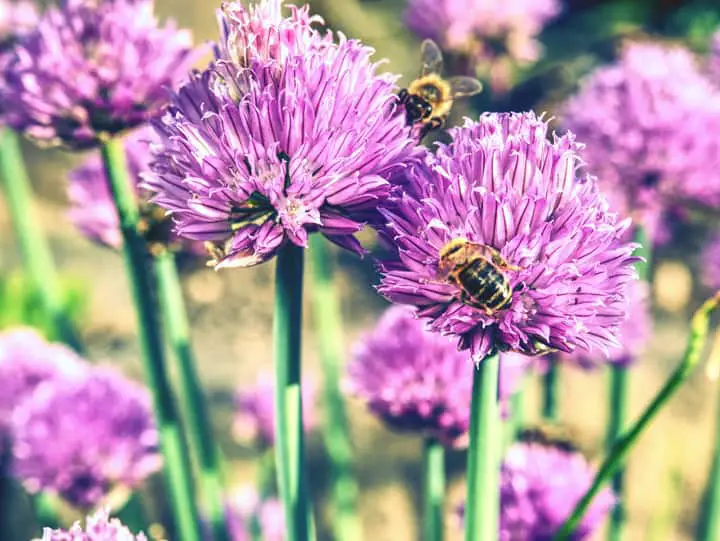
Chives are related to onions, garlic, and leeks. This flowering herb develops an edible purple blossom during the months of May and June. The website thespruceeats.com writes that chive blossoms are used as garnishes in salads, but can also be used to flavor soups, sauces, vinegars, and side dishes. Plant in pots to keep the fast-growing plant from overtaking the garden.
Coneflower

The coneflower, or echinacea, is a favorite among cottage gardeners. These pretty flowers not only attract bees but also butterflies. These daisy-like flowers come in pink and rose and stand on tall and erect stems. They bloom best in full sun to light shade. Coneflowers are tough plants with deep taproots that enable them to withstand periods without water. They flower throughout the summer and are beautiful in perennial borders.
Dahlia

According to daviddomoney.com the single or semi-flowered varieties are best for pollination because double flowers tend to be bred without pollen-producing parts. They are available in every color but blue, and grow from 1 foot tall to an incredible 7 feet tall. Flowers vary from a few inches across to the size of a dinner plate. Depending on size, dahlias look great in the front or back of the flower bed.
Daisy

The much-loved daisy varies in stature and bloom size, but the white flowers with a yellow button center are universal. They grow well in average to rich soil and established clumps are drought-tolerant. They look beautiful in any perennial border. Of course, in addition to being pretty flowers that attract bees, the daisy is also a great cut flower.
Dandelion

Okay, technically, the dandelion is a weed, but I’m still not convinced that it’s not a flower. And I know for a fact that these simple yellow flowers attract bees. As a barefoot little girl, I loved picking dandelions and creating yellow bouquets from the flowers. I also remember, more than once, stepping on a bee and getting stung. As much as I loved the dandelions, I think the bees loved them more. If you have a fussy formal garden, you might want to skip the dandelion. On the other hand, if you have an informal wild flower garden, the dandelion will feel right at home and all the bees will thank you.
Goldenrod

Lemon yellow or golden in color, goldenrod blooms in late summer and early fall. Goldenrods are not fussy flowers. They grow well even when neglected. They are comfortable in a meadow, prairie, woodland, and even alongside the road. Most species prefer average, moist but well-drained soil in full sun or light shade. Goldenrods do best if divided every 2 or 3 years.
Grape Hyacinth

No list of flowers that attract bees would be complete without the grape hyacinth. This pretty blue flower blooms in spring and the grape-like clusters make a pretty addition to any garden. They grow from bulbs and most varieties are 6 to 8 inches tall. They look beautiful combined with daffodils in borders or rock gardens.
Lavender

This fragrant herb has pretty spikes of scented purple flowers on top of upright stems. The leaves are grayish green and very aromatic. The flowers are used to make oil of lavender which is used in perfumes and soaps. They range in size from 1 to 3 feet tall and bloom for a month in early summer.
Liatris

Also called gayfeather, the liatris blooms resemble tall bottlebrushes and they are quite striking in the garden. They are available in rose, purple, and white. The plants are about 3 feet tall and look beautiful combined with ornamental grasses. They are easy to grow and among my favorite flowers that attract bees. Liatris are great for both formal and natural gardens and bees love them.
Lupine

Lupines form stately clumps of various colored flowers and most varieties are about 3 feet tall. They look pretty planted in masses and work great in formal borders or natural gardens. They bloom for as long as a month in early summer. Therefore, they are a great choice for attracting pollinators to your garden for a long time.
Marigold
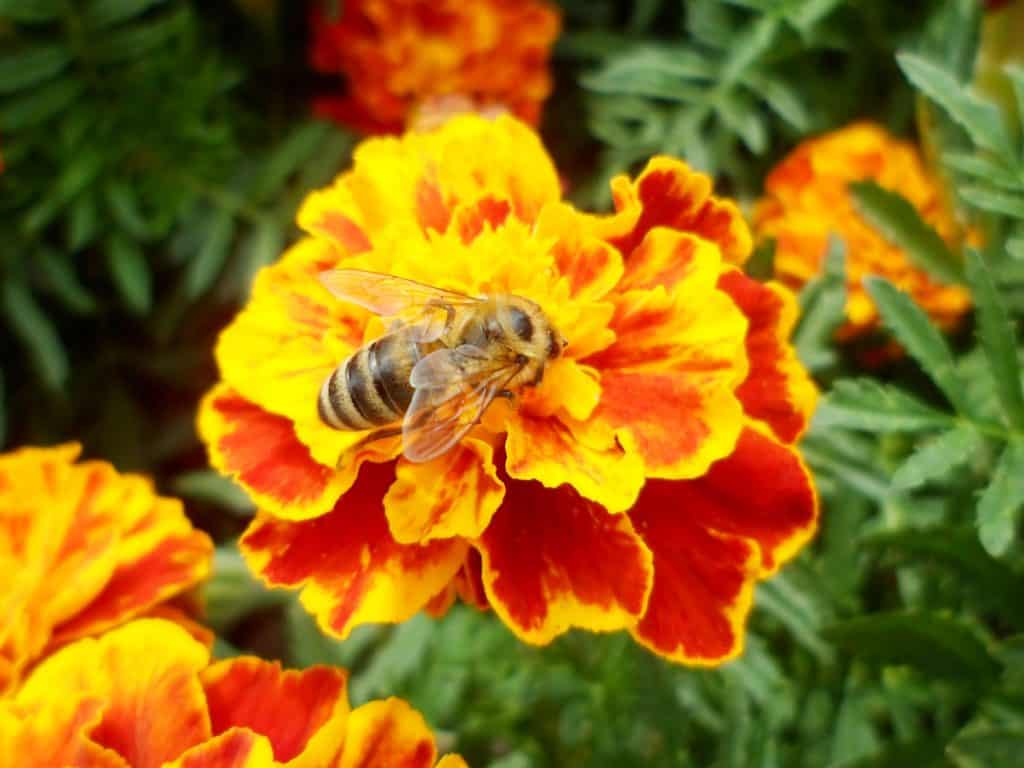
The Marigold is an orange or yellow annual that grows quickly from seed. As a result, the marigold is a great flower for beginners to plant. They germinate quickly, sprouting within a few days and blooming in about 8 weeks. They attract not only bees, but also butterflies and ladybugs. There are many varieties of marigold, most about 6 to 12 inches high, but some varieties grow as tall as 4 feet. They thrive in full sun and well-drained soil.
Mint

Bees and other pollinators are drawn to mint for its blue, pink, mauve, and white blossoms. Its familiar taste can be found in common products as diverse as tea and mouthwash. Mint is a frost-hardy perennial and is grown all year in areas with warm winters. It thrives in its natural state in meadows and along woodlands. When grown in the home garden, however, it is best to plant in containers for mint can be invasive. If you are looking for flowers that attract bees that you can also used in your tea or a mixed drink, you can’t go wrong with mint.
Milkweed

The milkweed is a common wildflower in most parts of the United States. According to beeculture.com, the milkweed is a favorite among bees and they will abandon other flowers in favor of the sweet nectar of the milkweed. Milkweed prefer full sun and will grow in any type of soil. Popular colors include red, white, yellow, orange, and purple.
Peony

Beautiful, fragrant, and long-lived, the much-loved peony is favorite among both gardeners and bees. The blooms are various shades of white, yellow and pinks, and some varieties are as big as 12 inches across. The beautiful bushes bloom in spring and prefer a spot where they will get sun for most of the day. They make beautiful cut flowers, but be sure to check them for ants before bringing them into the house. Like everyone else, ants also love peonies.
Phlox

Phlox grow in two varieties. The popular creeping variety is often seen spilling over rocks in the spring. The taller version, the garden phlox, grows upright and is available in red, white, pink, purple, and blue. Varieties of phlox include both perennials and annuals. The creeping variety look great in rock gardens or spilling out of containers such as an over turned bucket or wheelbarrow. The upright version look beautiful in borders. All varieties attract hummingbirds, butterflies, bees, and other pollinators.
Salvia

The salvia family of plants has a lot of variety. According to greengardenbuzz.com, one thing they all have in common is they are a magnet for all pollinators. If you have salvia growing in your yard, chances are you have rarely seen them without a hovering bee. They grow best in full sun, have a long bloom period, and are generally drought tolerant. Most varieties are red, pink, white, or dark purple. In height, they range from 12 inches to 6 feet tall.
Snapdragon
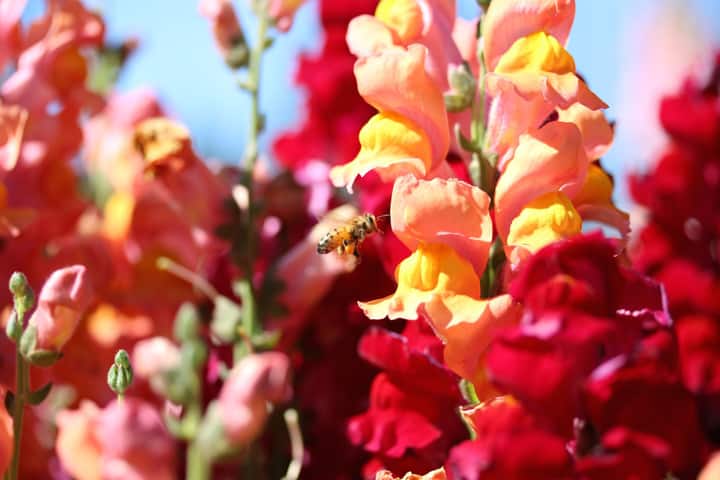
Snapdragons are great annual flowers for attracting pollinators. According to the website plantsforpollinators.weebly.com, snapdragons are so popular with bees that they are often used in the research of habits of pollinators. Depending on the variety, they range in size from 8 inches to 36 inches. They are available in a wide variety of colors and bloom from May until first frost. Therefore, they are a great choice for early flowers that attract bees.
Snowdrop

Snowdrops are a perennial bulb-forming plant that are among the first flowers to poke their heads from the snow in late winter and early spring. They are part of the Amaryllis family and are an excellent early foraging source for bees. Bulbs are planted in the fall for spring flowers. They prefer some shade and once established will self-seed and spread out. Their white blossoms look great in woodlands gardens.
Sunflower

Sunflowers thrive in areas where the summers are hot. They prefer loose, well-drained soil and need plenty of room to grow. Some varieties grow to 12 feet tall. They are rich in nectar and bees are attracted to their bright yellow color. Despite their size, sunflowers work best for attracting pollinators if they are grown in a group. Bees prefer to move from plant to plant collecting nectar so they are more attracted to multiple flowers. As a bonus, the seeds can also be roasted for a delicious snack.
Best Practice for Planting Flowers That Attract Bees
In summary, bees and other pollinators are most attracted to flowers, and flowering herbs, that grow in full sun. Plant masses of flowers instead of two or three of a variety because pollinators like to move from flower to flower to collect nectar. When you are deciding which variety to plant, remember pollinators are most attracted to flowers that are blue, purple, white, and yellow in color. When you plant flowers that attract bees, you not only are beautifying your own garden, but your are making the world a better place for the bees (and everyone else!).
Related Posts
- Best Florida Native Plants




